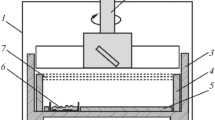Abstract
Phase behavior data are presented for simvastatin, a water-insoluble drug, in supercritical solvent mixtures of chlorodifluoromethane (CHClF2) and carbon dioxide (CO2). The solubilities of the simvastatin drug in the solvent mixtures of CHClF2 and CO2 were determined by measuring the cloud point pressures using a variable-volume view cell apparatus as functions of temperature, solvent composition, and amount of the drug loaded into the solution. The cloud point pressure increased with increasing the system temperature. As the CHClF2 composition in the solvent mixture increased, the cloud point pressure at a fixed temperature decreased. Addition of CHClF2 to CO2 caused an increase of the dissolving power of the mixed solvent for the simvastatin drug due to the increase of the solvent polarity. CHClF2 acted as a solvent for simvastatin, while CO2 acted as an anti-solvent. The cloud point pressure increased as the amount of the simvastatin drug in the solvent mixture increased. Consequently, the solubility of the simvastatin drug in the solvent mixture of CHClF2 and CO2 decreased with increasing the CO2 content in the solvent mixture as well as with increasing the system temperature.
Similar content being viewed by others
References
Bakhbakhi, Y., Charpentier, P.A. and Rohani, S., “Experimental study of the GAS process for producing microparticles of beclomethasone-17,21-dipropionate suitable for pulmonary delivery,” Int. J. Pharmaceutics, 309, 71 (2006).
Datea, A. A. and Patravale, V. B., “Current strategies for engineering drug nanoparticles,” Current Opinion in Colloid & Interface Science, 9, 222 (2004).
Duarte, A. R.C., Costa, M. S., Simplicio, A. L., Cardoso, M. M. and Duarte, C. M. M., “Preparation of controlled release microspheres using supercritical fluid technology for delivery of anti-inflammatory drugs,” Int. J. Pharmaceutics, 308, 168 (2006).
Fages, J., Lochard, H., Letourneau, J.-J., Sauceau, M. and Rodier, E., “Particle generation for pharmaceutical applications using supercritical fluid technology,” Powder Technol., 141, 219 (2004).
Ginty, P. J., Whitaker, M. J., Shakesheff, K. M. and Howdle, S. M., “Drug delivery goes supercritical,” Materials Today, 8,Supplement 1, 42 (2005).
Guney, O. and Akgerman, A., “Synthesis of controlled-release products in supercritical medium,” AIChE J., 48, 856 (2002).
Huang, Z., Sun, G.-B., Chiew, Y.C. and Kawi, S., “Formation of ultrafine aspirin particles through rapid expansion of supercritical solutions (RESS),” Powder Technol., 160, 127 (2005).
Kerc, J., Srcic, S., Knez, Z. and Sencar-Bozic, P., “Micronization of drugs using supercritical carbon dioxide,” Int. J. Pharmaceutics, 182, 33 (1999).
Kwak, H., Jung, J.W., Bae, S.Y. and Kumazawa, H., “Preparation of anthracene fine particles by rapid expansion of a supercritical solution process utilizing supercritical CO2,” Korean J. Chem. Eng., 21, 1245 (2004).
Lee, B.-C. and Kim, N.-I., “Phase equilibria of poly(methyl methacrylate) in supercritical mixtures of carbon dioxide and chlorodifluoromethane,” Korean J. Chem. Eng., 19, 132 (2002).
Lee, J.M., Lee, B.-C. and Hwang, S.-J., “Phase behavior of poly(L-lactide) in supercritical mixtures of carbon dioxide and chlorodifluoromethane,” J. Chem. Eng. Data, 45, 1162 (2000).
Lee, J. M., Lim, J. S. and Lee, Y.-W., “Effect of solvent composition and polymer molecular weight on cloud points of poly(L-lactide) in chlorodifluoromethane+carbon dioxide,” J. Chem. Eng. Data, 48, 774 (2003).
Miguel, F., Martin, A., Gamse, T. and Cocero, M. J., “Supercritical anti-solvent precipitation of lycopene: effect of the operating parameters,” J. Supercrit. Fluids, 36, 225 (2006).
Perrut, M., Jung, J. and Leboeuf, F., “Enhancement of dissolution rate of poorly-soluble active ingredients by supercritical fluid processes. Part I: Micronization of neat particles,” Int. J. Pharmaceutics, 288, 3 (2005).
Reverchon, E. and Adami, R., “Nanomaterials and supercritical fluids,” J. Supercritical Fluids, 37, 1 (2006).
Reverchon, E. and Della Porta, G., “Micronization of antibiotics by supercritical assisted atomization,” J. Supercrit. Fluids, 26, 243 (2003).
Reverchon, E. and Spada, A., “Erythromycin micro-particles produced by supercritical fluid atomization,” Powder Technol., 141, 100 (2004).
Rodier, E., Lochard, H., Sauceau, M., Letourneau, J.-J., Freiss, B. and Fages, J., “A three step supercritical process to improve the dissolution rate of eflucimibe,” European J. Pharmaceut. Sci., 26, 184 (2005).
Shekunov, B.Y. and York, P., “Crystallization processes in pharmaceutical technology and drug delivery design,” J. Crystal Growth, 211, 122 (2000).
Song, K.H., Lee, C.-H., Lim, J. S. and Lee, Y.-W., “Preparation of LPLA submicron particles by a continuous supercritical antisolvent precipitation process,” Korean J. Chem. Eng., 19, 139 (2002).
Steckel, H., Pichert, L. and Muller, B.W., “Influence of process parameters in the ASES process on particle properties of budesonide for pulmonary delivery,” European J. Pharmaceutics and Biopharmaceutics, 57, 507 (2004).
Thakur, R. and Gupta, R. B., “Formation of phenytoin nanoparticles using rapid expansion of supercritical solution with solid cosolvent (RESS-SC) process,” Int. J. Pharmaceutics, 308, 190 (2006).
Turk, M., Hils, P., Helfgen, B., Schaber, K., Martin, H.-J. and Wahl, M. A., “Micronization of pharmaceutical substances by the rapid expansion of supercritical solutions (RESS): A promising method to improve bioavailability of poorly soluble pharmaceutical agents,” J. Supercrit. Fluids, 22, 75 (2002).
Van Nijlen, T., Brennan, K., Van den Mooter, G., Blaton, N., Kinget, R. and Augustijns, P., “Improvement of the dissolution rate of artemisinin by means of supercritical fluid technology and solid dispersions,” Int. J. Pharmaceutics, 254, 173 (2003).
Won, D.-H., Kim, M.-S., Lee, S., Park, J.-S. and Hwang, S.-J., “Improved physicochemical characteristics of felodipine solid dispersion particles by supercritical anti-solvent precipitation process,” Int. J. Pharmaceutics, 301, 199 (2005).
Yeo, S.-D. and Kiran, E., “Formation of polymer particles with supercritical fluids: A review,” J. Supercritical Fluids, 34, 287 (2005).
Author information
Authors and Affiliations
Corresponding author
Rights and permissions
About this article
Cite this article
Oh, DJ., Lee, BC. & Hwang, SJ. Phase behavior of water-insoluble simvastatin drug in supercritical mixtures of chlorodifluoromethane and carbon dioxide. Korean J. Chem. Eng. 23, 1009–1015 (2006). https://doi.org/10.1007/s11814-006-0022-2
Received:
Accepted:
Issue Date:
DOI: https://doi.org/10.1007/s11814-006-0022-2




